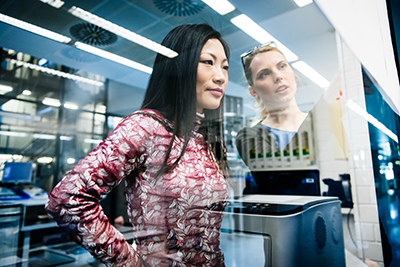In recognition of Black History Month, Women and Girls in Science Day, and Engineer’s Week, all in the short month of February, we’re opening the dialogue about women in the field of engineering.
Women represent more than half of the U.S. population and yet represent only 16% percent of its engineers. Yes, the number of women in the field has increased over the decades, but it’s still a small percentage. So, what can we do to change this?
Why aren’t there more women and black women in engineering?
It’s a more complex issue than we’re able to cover here, but we need to start the discussion somewhere!
We believe that if we don’t say anything, nothing will change. We need to talk about the lack of women and black women in engineering to bring attention to the inequity and lack of inclusion in the field.
In order to welcome more women and black women into engineering fields, we must start with their exposure to STEM in elementary school and through high school and beyond.
Is there even a need for more engineers?
Well, yes! The nation is watching thousands of engineers prepare for their retirement and there aren’t enough new engineers joining the workforce to replace them all. Due to increased automation in manufacturing and pulp and paper mills, there’s an increased demand for engineers to work with that technology to make processes as efficient and well-controlled as possible. In fact, if more women joined the field (specifically more black women) we would have an estimated 3,500 more engineers, according to a study by the National Society of Black Engineers (NSBE).
Fact: Only 6% of engineering degrees in the U.S. are awarded to Black women.
What can we do to encourage more women to be interested in STEM?
We need to encourage all students to study STEM subjects in school, but especially young girls. Here’s how we can start:
- Talk about it. We can change the language we use to describe engineering and what engineers do. We eliminate any technical jargon and explain how engineering solves real life problems and benefits society.
- Encourage interest in STEM. Society tells students, especially young girls, that they’re not good at math or science. But we know they are! Parents, educators, and mentors need to nurture any interest in STEM subjects early in a child’s life. All students need to know that they’re equally capable of flourishing in math and science subjects. We need to encourage their curiosity and explain the way engineers think, do, and work, and that being an engineer can be fun!
- Increase exposure to STEM programs. We must make all STEM subjects, projects, and programs more accessible to students of all genders and economic backgrounds. There are summer programs available all over the country (much like our Consider Engineering program), but we need to focus on creating more opportunities for these young students.
- Showcase Role Models. We need to show students all the amazing engineers in the world! We need to show young girls that there are successful women engineers out there and that they’ve been solving society’s problems and increasing quality of life for decades!
I don’t know any black or women engineers! Can you tell me about some?
We’re so glad you asked! When you think of well-known engineers, you may not be able to name a woman engineer, and that’s okay, but we’re determined to change that. How, you ask? By actively opening the STEM conversation to women and girls, sharing what engineers do and how they help society, and of course, showcasing the already successful women engineers out there.
In no particular order, here are four we’d like to highlight:
Donna Auguste
As a child, Donna was fortunate to have a family that supported her curiosity and encouraged her to ask questions and pull apart the family’s kitchen appliances.
She attended UC Berkley, and although she experienced discrimination from her professors and peers, she persisted and earned her electrical engineering and computer science degree. But that’s not all. She became the first Black woman to earn a master’s from Carnegie-Mellon and she also earned a PhD at the ATLAS Institute at the University of Colorado.
In the 1980s, Donna was a lead software engineer at Apple, her patents for the Newton Personal Digital Assistant (PDA) laying the groundwork for the iPhone and iPad. She served as CEO of her own software company, Freshwater software Inc., and created the Leave a Little Room Foundation. Donna retired when she sold her software company for over $147 million dollars.
Mae Jemison
Like Donna Auguste, Mae Jemison had family members that encouraged her to pursue science. She studied chemical engineering at Stanford at only 16 years old!
In the late 1980s, Mae’s NASA application was accepted, and she worked at the Kennedy Space Center on space shuttle software. She became the first black woman astronaut in 1992 when she left for her first week-long mission. Later, she created the Jemison Group that worked on advanced technologies and an international science camp called The Earth We Share that encourages science literacy for everyone.
Krystle McClain
Krystle McClain earned a chemical engineering degree and a master’s in environmental engineering and has worked for the Naval Facilities Engineering Command Far East since 2015. She currently leads as Commander of an environmentalist team of Technicians and Engineers in Japan.
Krystle actively encourages young students in her community to pursue STEM and STEM careers.
“It’s important to get more women and girls into STEM because we bring a different perspective to problem solving. Men and women are wired differently. What better way to ‘think outside the box’ then to have a woman/girl on your team?”- Krystle McClain
Aprille Ericsson-Jackson
Aprille’s interest in science began when she watched the Apollo space missions on TV as a child. She was determined to become an astronaut.
In 1986, she earned a Bachelor of Science in Aeronautical and Astronautical Engineering from MIT and a master’s in engineering from Howard University. Later, she became the first black woman to earn a PhD in mechanical engineering from Howard University and a second PhD in engineering at NASA Goddard Space Flight Center.
Her work has been essential in the further understanding of the solar system, advanced structural dynamics and spacecraft missions; she is also working on bringing back material from Mars.
“The U.S. cannot afford to lose more than half of its talent and the fresh perspective that women and minorities can bring to these critical fields. We must work together across the boundaries of skin color and gender.” – Aprille Ericsson-Jackson
Yvonne Clark
A true pioneer for African American and women engineers! Yvonne was recognized with numerous awards in her lifetime including the Women of Technology Award for Educational Leadership, Adult Black Archivers Award, and the President’s Distinguished Service Award.
She was the first woman to earn a Bachelor of Science in mechanical engineering at Howard University, a master’s degree in engineering management from Vanderbilt University, and the first woman faculty member in the College of Engineering and technology at Tennessee State University. It was here she ultimately retired as a professor in 1988.
“Prepare yourself. Do your work. Don’t be afraid to ask questions and benefit by meeting with other women. Whatever you like, learn about it and pursue it. The environment is what you make it—sometimes the environment is hostile, but don’t worry about it. Be aware of it so you aren’t blind-sided.” – Yvonne Clark
If this topic inspired you, we’d love to hear from you. Learn more about how we help engineering students here.


Recent Comments